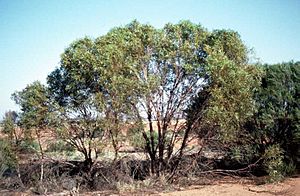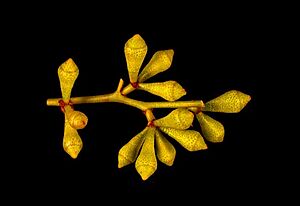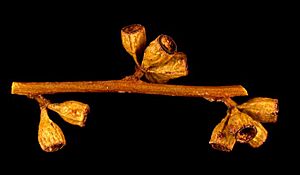Mukinbudin mallee facts for kids
Quick facts for kids Mukinbudin mallee |
|
|---|---|
 |
|
| Eucalyptus brevipes near Bonnie Rock | |
| Conservation status | |
| Scientific classification | |
| Genus: |
Eucalyptus
|
| Species: |
brevipes
|
The Mukinbudin mallee (scientific name: Eucalyptus brevipes) is a special type of eucalyptus tree that only grows in Western Australia. It has rough, stringy bark on its main trunk and bigger branches. Higher up, the bark is smooth and can be grey or pinkish. Its grown-up leaves are long and thin, like a spear. The tree produces white flowers from buds that grow in groups of seven. After flowering, it forms fruit that looks like a cylinder or a small barrel.
About the Mukinbudin Mallee
The Mukinbudin mallee is a type of eucalyptus tree that usually grows to be about 3 to 5 metres (10 to 16 ft) tall. It has a special woody swelling at its base called a lignotuber. This helps the tree regrow after a fire. The bark on its main trunk and bigger branches is rough and flaky. But on smaller branches (less than 5 centimetres (2 in) wide), the bark is smooth and can be grey or pinkish.
Young plants and new shoots have long, thin leaves, about 50–80 mm (2.0–3.1 in) long and 7–15 mm (0.28–0.59 in) wide. As the tree gets older, its leaves become shiny and stand upright. These adult leaves are also long and thin, measuring about 70–125 mm (2.8–4.9 in) long and 7–10 mm (0.28–0.39 in) wide, often with a small hook at the tip.
The flowers grow in groups of seven. Each group is found in the "armpit" of a leaf (called an axil) on a short stalk, or peduncle, about 2–6 mm (0.079–0.24 in) long. Each individual flower has its own tiny stalk, called a pedicel, about 2–4 mm (0.079–0.16 in) long.
The flower buds are oval or pear-shaped, about 7–8 mm (0.28–0.31 in) long and 3–5 mm (0.12–0.20 in) wide. They have a cone-shaped cap, or operculum, about 2–3 mm (0.079–0.12 in) long. The Mukinbudin mallee flowers from July to September, producing white or creamy white blooms. After flowering, it develops woody, barrel-shaped or cup-shaped fruits, called capsules. These fruits are about 6 to 7 mm (0.24 to 0.28 in) long and 4 to 7 mm (0.16 to 0.28 in) wide, sitting on a pedicel about 1–4 mm (0.039–0.16 in) long. This tree looks a bit like Eucalyptus gracilis, but you can tell them apart because the Mukinbudin mallee has leaves that stand upright.
How it Got its Name
The scientific name Eucalyptus brevipes was first officially described in 1986 by a scientist named Ian Brooker. He wrote about it in a science journal called Nuytsia. He found the first sample of this tree near Cunderin Hill, which is between Mukinbudin and Bonnie Rock.
The second part of its scientific name, brevipes, comes from two Latin words: brevis, meaning "short," and pes, meaning "foot." This name refers to the short stalks (pedicels) that hold the individual flowers.
Where it Grows
The Mukinbudin mallee is found in the Wheatbelt region of Western Australia. It likes to grow near granite rocks, especially between the towns of Mukinbudin and Nungarin. It prefers sandy-loamy soils. You can often find it in open, low scrub areas alongside other eucalyptus trees like Eucalyptus loxophleba and Eucalyptus kochii, as well as Acacia acuminata.
Scientists know of 14 different groups, or populations, of this tree. Ten of these groups grow on land that isn't owned by anyone in particular, called crown land. It's estimated that there are about 320 mature trees in nine of these populations, spread out over an area of about 1,780 square kilometres (687 sq mi).
Conservation Status
The Mukinbudin mallee is considered an "endangered" species by the Australian Government under a law called the Environment Protection and Biodiversity Conservation Act 1999. It is also listed as "Threatened Flora" by the Department of Environment and Conservation (Western Australia).
The biggest dangers to this tree are fires, road construction, and the maintenance of firebreaks (areas cleared to stop fires). However, scientists believe that the Mukinbudin mallee can regrow from its special woody base (lignotuber) even after a fire.




